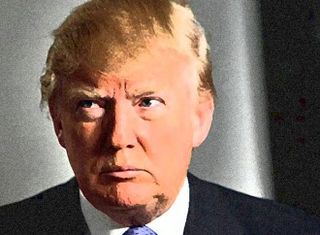President Donald Trump
The Trump Effect Part 1
How one man's erratic behavior affects a nation.
Posted March 30, 2017

We’ll start with a little backstory: Last month we published a column titled "The Elephant in the Room: It's time we talked openly about Donald Trump's mental health." To our great surprise it went viral. We wrote it in response to an earlier post by Psychology Today's editorial staff, "Shrinks Battle Over Diagnosing Donald Trump: Chaos in the White House Fuels Discord Amongst the Experts." Our intention was to expand on and update the earlier post, and to underscore the dilemma confronting thousands of mental health professionals—the apparent conflict between a standard which first appeared in the APA's Code of Ethics in 1973 known as The Goldwater Rule (barring the diagnosis of pubic figures you have not met with in person) and the ethical standard of The Duty to Warn (the moral obligation of mental health professionals to warn others of the threat of harm from a specific person). We made our stance clear: we believe The Duty to Warn outweighs The Goldwater Rule. In the comment section of the post, professionals weighed in on both sides. Some stated it is unethical to diagnose via media appearances alone, much less share that diagnosis while others agreed that The Duty to Warn outweighed The Goldwater Rule, which some consider outdated in this instance.
The Trump Effect
We will devote our next two columns to "The Trump Effect,"* originally defined as an increase in bullying in schools caused by the rhetoric used by Donald Trump during his campaign. This particular definition—not to be confused with other meanings in reference to the stock market, publicly skirting the truth, or the uptick in populism in Europe—gained traction in the media (see links below) as campaign season deepened and Donald Trump won the election.
The bullying noted earlier has crept beyond schools to include religious and racial bullying by adults. Two mosques were burned to the ground in Texas. Jewish cemeteries across our nation have been desecrated. Two innocent Eastern-Indian engineers were shot while having dinner as was a white American who tried to intervene. One of the engineers died, as his killer yelled at him, “Get out of my country!”
In recent weeks, articles about the effect have largely been replaced by continuing coverage of tweets, odd behaviors, and his team's possibly illegal ties to Russia. Did The Trump Effect go away? And how far reaching are its affects? In this column we’ll focus on The Trump Effect in regards to bullying and violent acts of discrimination. In the next column our focus will be on The Trump Effect and misogyny/sexual assault.
The Trump Effect in our schools
In "The Trump Effect: The Impact of the 2016 Presidential Campaign on our Nation’s Schools," a report by Maureen Costello of the Southern Poverty Law Center’s (SPLC) Teaching Tolerance program, the dire consequences of Donald Trump’s behavior is presented in no uncertain terms. (The Southern Poverty Law Center (SPLC) is a non-partisan, not-for-profit organization founded in 1971 dedicated to fight hate and bigotry, and to seek justice for the most vulnerable members of society. Its Teaching Tolerance team is devoted to reducing prejudice among youth, promoting equality, inclusiveness, and equitable learning in schools.)
Concerned about the glaring differences between previous presidential campaigns and the 2016 campaign, SPLC/Teaching Tolerance conducted a nationwide survey of teachers from March 23 to April 2, 2016. Two thousand K-12 teachers participated in the on-line survey and the teachers responded with over five thousand comments. The results revealed that the campaign was having a “profoundly negative effect on children and classrooms.” Further, the report showed “a disturbing nationwide problem, one that is particularly acute in schools with high concentrations of minority children.”
Immigrant students, children of immigrants (close to one-third of children in U.S. classrooms are children of foreign-born parents), African Americans and other students of color were fearful while their friends worried and wanted to protect them. But many children were not afraid at all. Rather, some used the word "Trump" as a taunt or chant as they ganged up on others. Muslim children were called terrorists, those of Mexican descent told they or their parents would be deported, children of color afraid they would be rounded up and put into camps. The bullying caused some of these children to have panic attacks and suicidal thoughts. Many of the gains made by years of anti-bullying work in schools were lost in just a few months. Teachers reported that students were emboldened to use slurs, engage in name-calling and make inflammatory statements toward each other. When confronted, students pointed to the candidates and claimed they were “just saying what everyone is thinking.”
The report states:
“Overall, these vulnerable students are disillusioned and depressed at the hatred they’re hearing from candidates, in the news, from classmates and even, sometimes, from trusted adults. They’re discouraged to find out what people really think. Undocumented students or students with undocumented family members are especially vulnerable. These students have a legal right to a public school education, but many of them come to school every day fearful that their families will be separated…In many cases, the students are American citizens or come from families that are here legally. It doesn’t matter: Regardless of immigration status, they feel under attack. We heard about students from second grade to high school crying in class.”
But a consistent theme across grade levels emerged: students understood the behavior on display was not okay. We have to add that our research reveals another negative fallout of bullying, beyond its targeted victims—the great many people who witness it and do nothing—as passive bystanders. Many of them feel prolonged shame for their inaction against this injustice experienced by friends and classmates.
Long-term impact
While the long-term impact of these noxious experiences on children’s well-being may be impossible to measure, the students were stressed and anxious in a way that threatens their health, emotional well-being, and their schoolwork. Its common knowledge that stressed students have a more difficult time learning and in the report, there were many instances that indicated anxiety was having an impact on grades and the ability to concentrate. But all students, regardless of whether or not they are members of a targeted group, are vulnerable to the stresses of The Trump Effect.
The dangerous effect of bullying on children is well-known by most in our country. It affects health, academic achievement, and in some cases, can lead to self-harm. For years, schools have implemented comprehensive policies and programs to prevent and address bullying. And in many schools, these programs have made a real difference in creating a culture of respect. Unfortunately, due to the erratic actions of one man, much of that hard work has been undone.
Racial and Religious implications
Children are a reflection of their upbringing. More than likely, the angry acting-out of some students toward others in our schools is a reflection of what they observe in their homes. So how has a small but active segment of our population been reacting to Donald Trump’s presidency? They have become even more emboldened and, in recent months, taken to including attacks on Jews in the mix of Muslim and Mexican hate-crimes, harboring speculation about Trump’s appeal to white supremacy/anti-Semite groups.
According to the SPLC, in the two week period between Election Day and February 9 there were seventy anti-Jewish incidents and thirty-one anti-Muslim – the majority being bomb threats. This mirrors the ratio of Jews to Muslims populations in the U.S. which means Jews and Muslims have a roughly equal chance of being victimized. But six weeks have passed since the gathering of this data and these numbers don’t take into account the attacks that have happened since then.
The recent rash of Jewish grave yard desecrations and places of worship, as well as the burning of mosques, should be devastating to all of us as Americans, as we are a nation composed largely of immigrants. These insults against the identity of Jews and Muslims promote the dehumanization of fellow human beings. And although the president was eventually forced to condemn anti-Semitism, in our research for this article, we could find no evidence of his condemnation of the terrorist attacks against American Muslims. This reluctance to serve and protect segments of his population is yet another sign for the haters that their behavior is acceptable to the man in charge.
However, in the midst of these terrorist attacks, something wonderful has emerged from the ashes: the spirit of overwhelming goodness in humanity. Jews and Muslims have united to collaborate in the wake of attacks, holding fundraisers to help each other repair and rebuild, sharing places of worship to hold gatherings and services, and offering loving support while facing hatred. Through these acts of compassion and every day heroism, they display the best aspects of humanity.
What we can do
We all have the right to free speech and to express our opinions. It is up to others to listen. But when the speaker is the president, we all listen. And when the President uses inflammatory rhetoric that causes more harm than good, what can we do?
We can start by realizing we have no control over others or their behaviors. We only really have control over ourselves; what we think, what we choose to say, and how we act and react. We can choose to be cruel, or to be kind. We can choose to inflame, or to quench. No matter what we choose, our children notice our actions—for good, or for ill. And like the children mentioned in the study above, we understand the behavior on display—that of our President - is not okay.
We remain optimists amid the current crises, believing the best in human nature will triumph over Trump's negativity-generating presidency.
*There was also an “Obama Effect” which generally had to do with anti-discrimination; and a “Hillary Clinton Effect” in reference to women running for political office.
***
See: Time Perspective Therapy; The Time Cure; and The Time Paradox. Learn more about yourself and helpful ways to cope with life’s stress at Discoveraetas; watch The River of Time. See Phil Zimbardo's Heroic Imagination Project
Click here to read a psych2go.net interview of Rose Sword by Sosa Manuel, aka Elliot Figueira. Psych2go.net’s mission is to make psychology available to everyone; it is for millennials, by millennials.
***
Articles/reports about The Trump Effect:
The Trump Effect on Domestic Violence: What’s at Stake? by Zoe Flowers.
The Trump Effect: The President’s Wild Start Churns Domestic Politics Around the World, by Carol E. Lee, Anton Troianovski, and Santiago Perez, The Wall Street Journal.
Why is Trump Silent on Isamlaphobic Attacks? The president has faced pressure to condemn anti-Semitism, but does not face the same demands to condemn anti-Muslim sentiment, by Peter Beinart; The Atlantic.
PsychologyToday.com articles re: The Trump Effect, by category:
General:
What is The Trump Effect? Let’s focus on human similarities, not differences, by Samuel Veissiere, Phd.
Go Back to Your Country: How are we deceiving ourselves as a result of our biases, by Mark B. Baer.
The Dangers of Dehumanization: Research suggests that anti-Immigration rhetoric makes all Americans feel less safe, by Benjamin Mitchell Yellin.
Sexual Assault:
A Trump Effect for Sexual Harassment and Assault Memories: Trump creates a national conversation about sexual harassment and assault, by Ira Hyman.
You Are Not Alone in Being Re-traumatized by Trump: When triggers by Trump, look for safe havens in others, by Suzanne Lachmann. https://www.psychologytoday.com/blog/me-we/201702/you-are-not-alone-in-…-
Bullying:
The “Trump Effect” in the Workplace: There are so many excuses for stupid or harassing behavior in the office, by Steven Albrecht.
Where are Bystander Interventions to Trump’s Bullying? Why are overtures so ineffectual? by Laura Martocci.
Children/Youth:
Managing Trump-Related Tears, Fears, and Taunts in Kids: Across the US teachers report kids are scared family members will be deports, by Victoria L. Dunckley.
Is Your Child More Anxious and Worried Since the Election: Are parent’s creating more fear for their children about the future? by Allison Carmen.
What’s Trump’s Actions Really Mean for Transgender Students: Five things for advocates and allies for transgender youth need to know and do, by Elizabeth J. Meyer.
References
Costello, Maureen B. "The Trump Effect: The Impact of the Presidential Campaign in our Nation's Schools". Southern Poverty Law Center
Berman, Mark. "FBI investigating shooting of two Indian men in Kansas as hate crime". Washington Post.
Michaelson, Jay. "What the Jewish Cemetery Attack and Trump’s Movement have in Common: The president is not an anti-Semite but he is the head of an anti-Semite movement". The Daily Beast.
Green, Emma. "Why Attacks on Jewish Cemeteries Provoke Particular Fear: Each new incident assumes added significance Muslims and Jews who see them as part of a broader pattern". The Atlantic.




